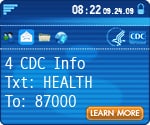I wanted to highlight two points I heard during a terrific recent webinar, “Social Media and Technology Breakthroughs: H1N1 and Seasonal Flu Communication”:Â Â one about the Centers For Disease Control’s (CDC) view that mobile phones have an increasingly valuable role in public health communications and another about Philadelphia Office of Emergency Management’s expanded use of Twitter.
In her presentation, CDC new media official Ann Aikin underscored the growing importance of cellphones in public health communications. She cited an April 2009 study from the Pew Internet and American Life Project, Mobile Access to Data and Information, that estimated there were 276.3 million cellphone users in the U.S., which is 87% of the population. She noted further that CDC surveys have found that cellphone-only households tend to be more at-risk on healthcare as a percentage than households that also have a landline phone (ie. 19% of cellphone-only households had a flu shot last year versus 36% for the cell and landline group).

This is a particularly interesting point, because there has been some concern expressed by government officials about using mobile devices as a distribution tool. The worry is that it would exacerbate a perceived “digital divide” putting less well off citizens at a disadvantage. That has, for example, kept many emergency management sites from adding a mobile phone (and backup power source) to their recommended list of supplies. But during the webinar Aikin made the point that the “divide” does not exist in mobile phones and that in fact the mobile-only population is being underserved if that channel is not fully utilized.
In a follow-up email, I asked Aikin to further address the “digital divide” worries of some in the emergency preparedness community about new media. She said that there continues to be a socioeconomic discrepancy on home computer ownership but not on mobile phones:
“As a part of our overall mission, we are committed to finding strategies and innovative solutions for reaching underserved populations and providing important health information to those who are disproportionately affected by health disparities…we’ve carefully looked at research from a number of organizations to better reach underserved groups and other target audiences. Mobile technologies, like the text messaging pilot, are a great way to extend reach across racial, ethnic, and socioeconomic lines at a higher rate than, for example, the use of home computers or landlines.
Another example of using phones to reach underserved audiences would be a partnership with Community Voice Mail, a group that provides individual voice mail services. We’ve worked with them to provide important health information to their clients in the form of voice mails and emails. You can learn more about Community Voice Mail at their web site, CVM.org.”
The CDC text messaging pilot Aikin mentions above allows members of the public to receive updated flu information on their mobile devices. To sign up, go here.
In his webinar presentation, preparedness 2.o guru David Stephenson highlighted the Twitter page of the Philadelphia Office of Emergency Management. Stephenson pointed out that the site, PhilaOEM, was “following” more than 2000 Twitter feeds, many of which are those of Philadelphia citizens.
Most government Twitter pages tend not to ‘follow’ any non-governmental Twitter feeds and usually do not follow members of the public. PhilaOEM is being aggressive in adding Philadelphians to its ‘follow’ list, according to Stephenson, because they view the public as a resource during an emergency. And the Department sees Twitter as a way to begin setting up those two-way relationships in advance.

The webinar was sponsored by Booz Allen Hamilton’s Center of Excellence for Risk & Crisis Communications, the American Public Health Association and the International Association of Emergency Managers. The other two panelists were: Corrie Conrad, Senior Associate, Global Public Health, Google.org and David Cerino, GM, Microsoft Health Solutions Group. The full webinar (along with another one on the same topic conducted last month) can be found here.





1 response so far ↓
1 Louisiana State Preparedness Office Reaches Out & Thanks Its Oil Spill Response ‘Tweeps’ // May 11, 2010 at 2:11 pm
[...] media to accelerate the two-way communication between government and citizen and help develop a community of civilians who can be a resource going forward. It also engenders good will. So, when @GOHSEP asked its tweeps to consider using its [...]
Leave a Comment